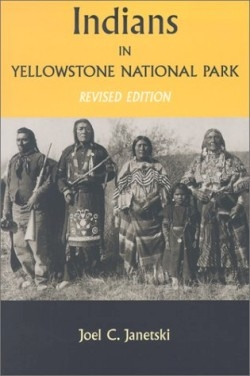Indians in Yellowstone National Park
In 1879, “an octagon turret or gun-room, nine feet in diameter and ten feet high—holed for rifles” was built as part of an office fortress at Yellowstone National Park. Previous events, such as the Nez Perce War in 1877, had probably led the park’s superintendent to believe that the building was warranted to quell possible Indian attacks. It was torn down thirty years later, having never been used.
This book traces the history of Native Americans in and around Yellowstone. The oldest national park in the world, it was established in 1872, although Indians still lived and hunted there. Tourists also roamed freely then, and it appears that park administrators reassured them by spreading the erroneous information that the Indians were fearful of the natural geysers and hot springs. The author points to recent theories that the thermal wonders of the park were, in actuality, seen as useful and even sacred by the native people. While some visited the “spirits,” hoping to obtain power via visions and dreams, others simply “took advantage of the hot water by using it for cooking.”
Janetski is professor of anthropology and director of the Museum of Peoples and Cultures at Brigham Young University. His book studies the Yellowstone area’s inhabitants from prehistoric times up to the early- to mid-twentieth century, including an overview of the introduction of the horse by the Spanish during the 1600s, and its long-ranging effects on the native inhabitants.
Some of the most interesting aspects of the book are Janetski’s close examinations of the Indian way of life. Living within the park at one time were a people known as the Sheepeaters, so named because the bighorn sheep provided them with an important food staple. They made excellent bows, “beautifully wrought from Sheep, Buffalo, and Elk horns secured with Deer and Elk sinews, ornamented with porcupine quills, and about three feet long.”
Some of the events brought to light are likely to cause readers to shake their heads. The Indians initially retained park hunting rights in an 1868 treaty, but subsequently lost them because the activity was deemed illegal under Wyoming state law. The author describes the Indian skirmishes of the late 1870s as the last resort of a once-proud people. In the words of Nez Perce Chief Joseph: “I am tired; my heart is sick and sad. I will fight no more forever.”
Disclosure: This article is not an endorsement, but a review. The publisher of this book provided free copies of the book to have their book reviewed by a professional reviewer. No fee was paid by the publisher for this review. Foreword Reviews only recommends books that we love. Foreword Magazine, Inc. is disclosing this in accordance with the Federal Trade Commission’s 16 CFR, Part 255.

